MSc Dissertation: Green Technology Application in Construction Field
VerifiedAdded on 2023/06/11
|37
|9566
|64
Thesis and Dissertation
AI Summary
This dissertation explores the application of green technology in the field of construction, focusing on its importance in reducing environmental impact and promoting sustainable building practices. It examines various energy-saving technologies, including building layout optimization, exterior wall insulation, indoor environment control systems, solar energy utilization, and reclaimed water systems. The research methodology includes data collection and analysis to determine the suitability and feasibility of implementing green technologies in construction projects, considering social, economic, and political factors. The findings highlight the significance of green technology in achieving environmental goals and reducing greenhouse gas emissions, while also addressing challenges related to inconsistent building codes and standards across different regions. Desklib provides access to this and other solved assignments.
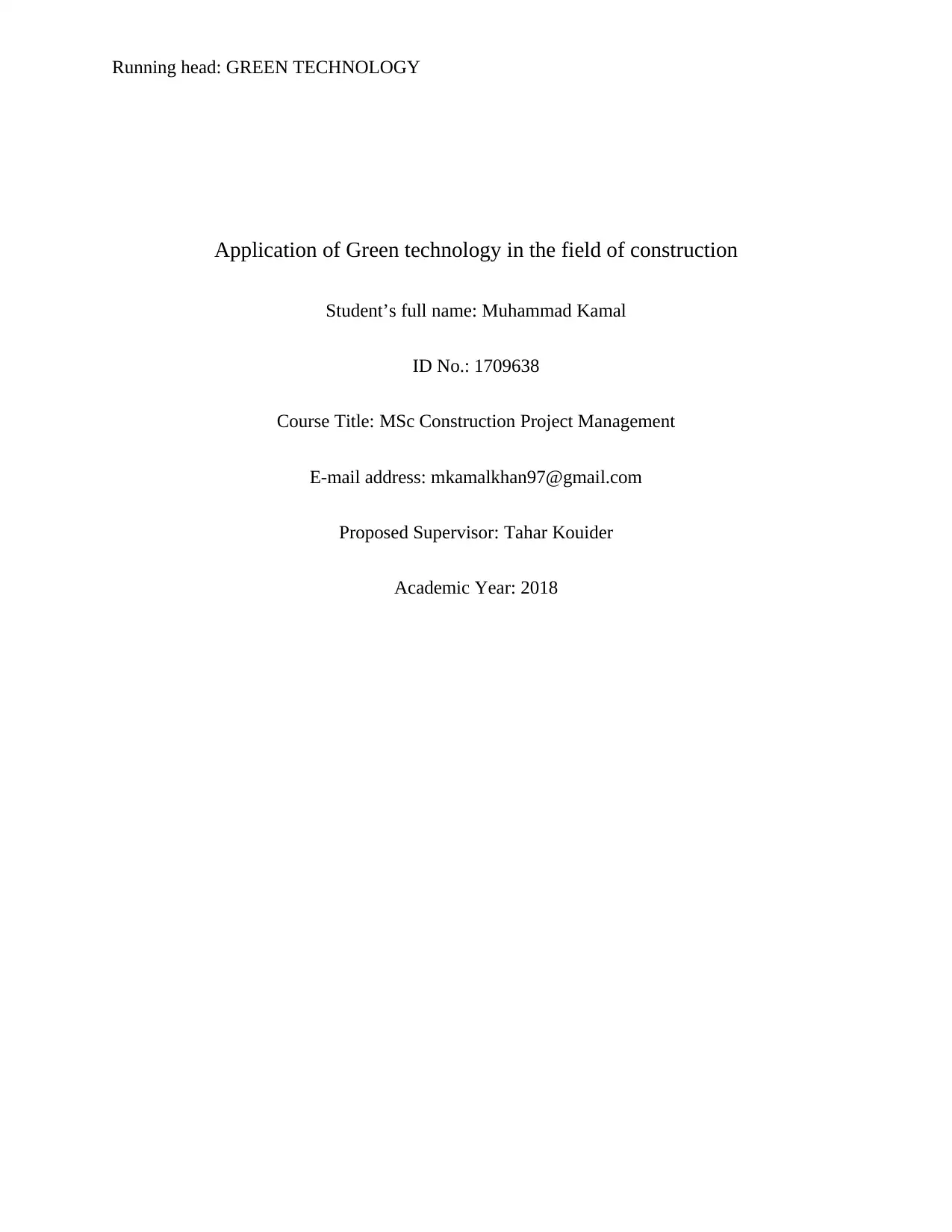
Running head: GREEN TECHNOLOGY
Application of Green technology in the field of construction
Student’s full name: Muhammad Kamal
ID No.: 1709638
Course Title: MSc Construction Project Management
E‐mail address: mkamalkhan97@gmail.com
Proposed Supervisor: Tahar Kouider
Academic Year: 2018
Application of Green technology in the field of construction
Student’s full name: Muhammad Kamal
ID No.: 1709638
Course Title: MSc Construction Project Management
E‐mail address: mkamalkhan97@gmail.com
Proposed Supervisor: Tahar Kouider
Academic Year: 2018
Paraphrase This Document
Need a fresh take? Get an instant paraphrase of this document with our AI Paraphraser
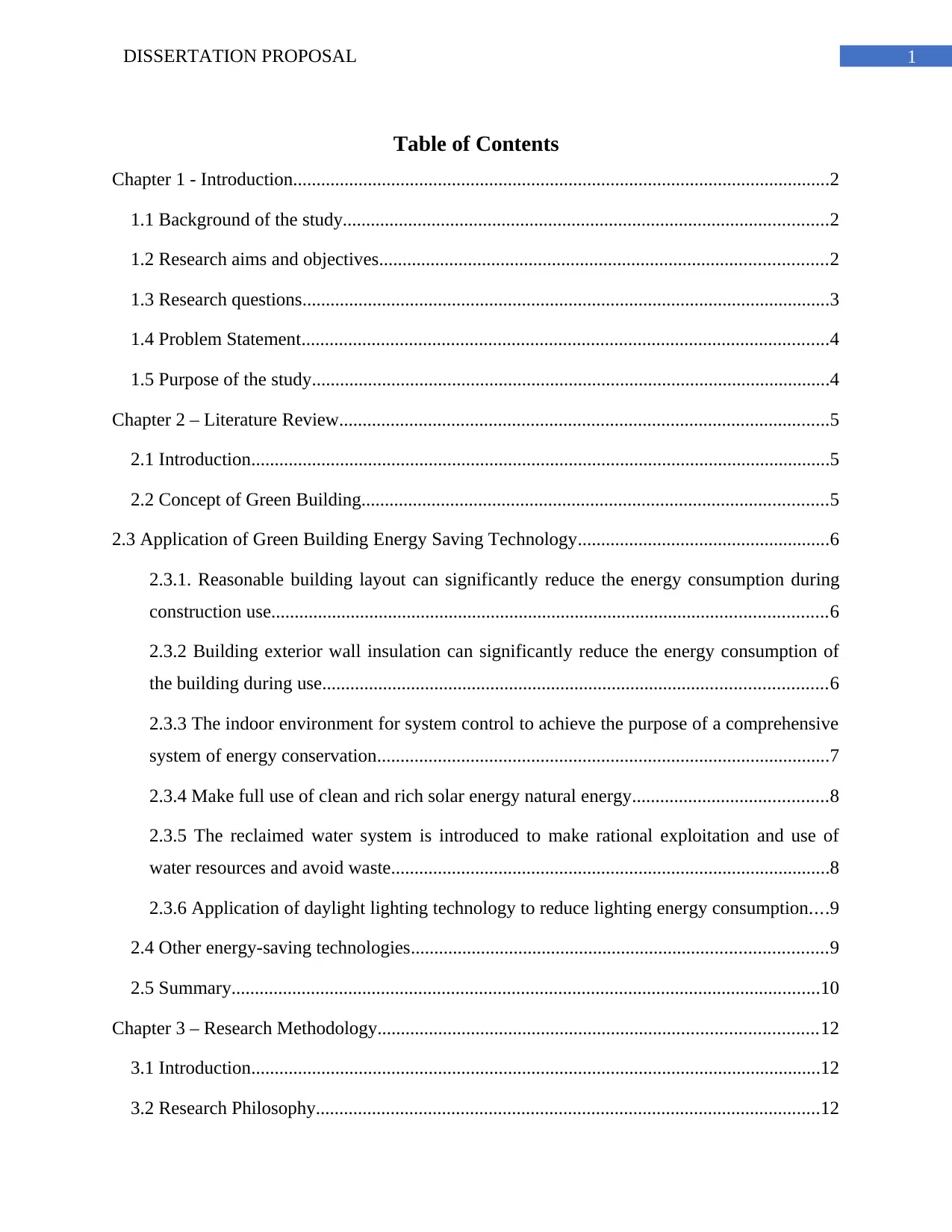
1DISSERTATION PROPOSAL
Table of Contents
Chapter 1 - Introduction...................................................................................................................2
1.1 Background of the study........................................................................................................2
1.2 Research aims and objectives................................................................................................2
1.3 Research questions.................................................................................................................3
1.4 Problem Statement.................................................................................................................4
1.5 Purpose of the study...............................................................................................................4
Chapter 2 – Literature Review.........................................................................................................5
2.1 Introduction............................................................................................................................5
2.2 Concept of Green Building....................................................................................................5
2.3 Application of Green Building Energy Saving Technology......................................................6
2.3.1. Reasonable building layout can significantly reduce the energy consumption during
construction use.......................................................................................................................6
2.3.2 Building exterior wall insulation can significantly reduce the energy consumption of
the building during use............................................................................................................6
2.3.3 The indoor environment for system control to achieve the purpose of a comprehensive
system of energy conservation.................................................................................................7
2.3.4 Make full use of clean and rich solar energy natural energy..........................................8
2.3.5 The reclaimed water system is introduced to make rational exploitation and use of
water resources and avoid waste..............................................................................................8
2.3.6 Application of daylight lighting technology to reduce lighting energy consumption....9
2.4 Other energy-saving technologies.........................................................................................9
2.5 Summary..............................................................................................................................10
Chapter 3 – Research Methodology..............................................................................................12
3.1 Introduction..........................................................................................................................12
3.2 Research Philosophy............................................................................................................12
Table of Contents
Chapter 1 - Introduction...................................................................................................................2
1.1 Background of the study........................................................................................................2
1.2 Research aims and objectives................................................................................................2
1.3 Research questions.................................................................................................................3
1.4 Problem Statement.................................................................................................................4
1.5 Purpose of the study...............................................................................................................4
Chapter 2 – Literature Review.........................................................................................................5
2.1 Introduction............................................................................................................................5
2.2 Concept of Green Building....................................................................................................5
2.3 Application of Green Building Energy Saving Technology......................................................6
2.3.1. Reasonable building layout can significantly reduce the energy consumption during
construction use.......................................................................................................................6
2.3.2 Building exterior wall insulation can significantly reduce the energy consumption of
the building during use............................................................................................................6
2.3.3 The indoor environment for system control to achieve the purpose of a comprehensive
system of energy conservation.................................................................................................7
2.3.4 Make full use of clean and rich solar energy natural energy..........................................8
2.3.5 The reclaimed water system is introduced to make rational exploitation and use of
water resources and avoid waste..............................................................................................8
2.3.6 Application of daylight lighting technology to reduce lighting energy consumption....9
2.4 Other energy-saving technologies.........................................................................................9
2.5 Summary..............................................................................................................................10
Chapter 3 – Research Methodology..............................................................................................12
3.1 Introduction..........................................................................................................................12
3.2 Research Philosophy............................................................................................................12
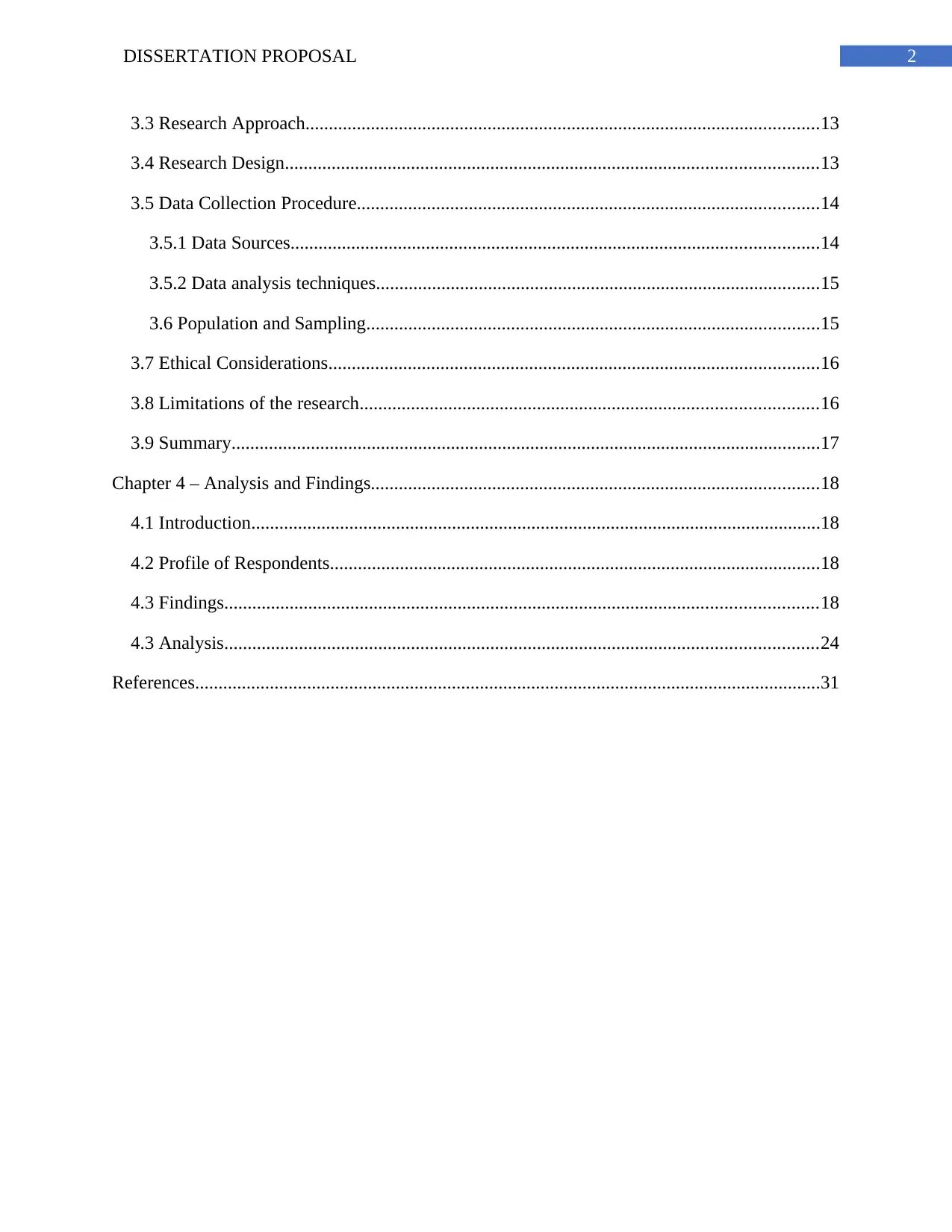
2DISSERTATION PROPOSAL
3.3 Research Approach..............................................................................................................13
3.4 Research Design..................................................................................................................13
3.5 Data Collection Procedure...................................................................................................14
3.5.1 Data Sources.................................................................................................................14
3.5.2 Data analysis techniques...............................................................................................15
3.6 Population and Sampling.................................................................................................15
3.7 Ethical Considerations.........................................................................................................16
3.8 Limitations of the research..................................................................................................16
3.9 Summary..............................................................................................................................17
Chapter 4 – Analysis and Findings................................................................................................18
4.1 Introduction..........................................................................................................................18
4.2 Profile of Respondents.........................................................................................................18
4.3 Findings...............................................................................................................................18
4.3 Analysis...............................................................................................................................24
References......................................................................................................................................31
3.3 Research Approach..............................................................................................................13
3.4 Research Design..................................................................................................................13
3.5 Data Collection Procedure...................................................................................................14
3.5.1 Data Sources.................................................................................................................14
3.5.2 Data analysis techniques...............................................................................................15
3.6 Population and Sampling.................................................................................................15
3.7 Ethical Considerations.........................................................................................................16
3.8 Limitations of the research..................................................................................................16
3.9 Summary..............................................................................................................................17
Chapter 4 – Analysis and Findings................................................................................................18
4.1 Introduction..........................................................................................................................18
4.2 Profile of Respondents.........................................................................................................18
4.3 Findings...............................................................................................................................18
4.3 Analysis...............................................................................................................................24
References......................................................................................................................................31
⊘ This is a preview!⊘
Do you want full access?
Subscribe today to unlock all pages.

Trusted by 1+ million students worldwide
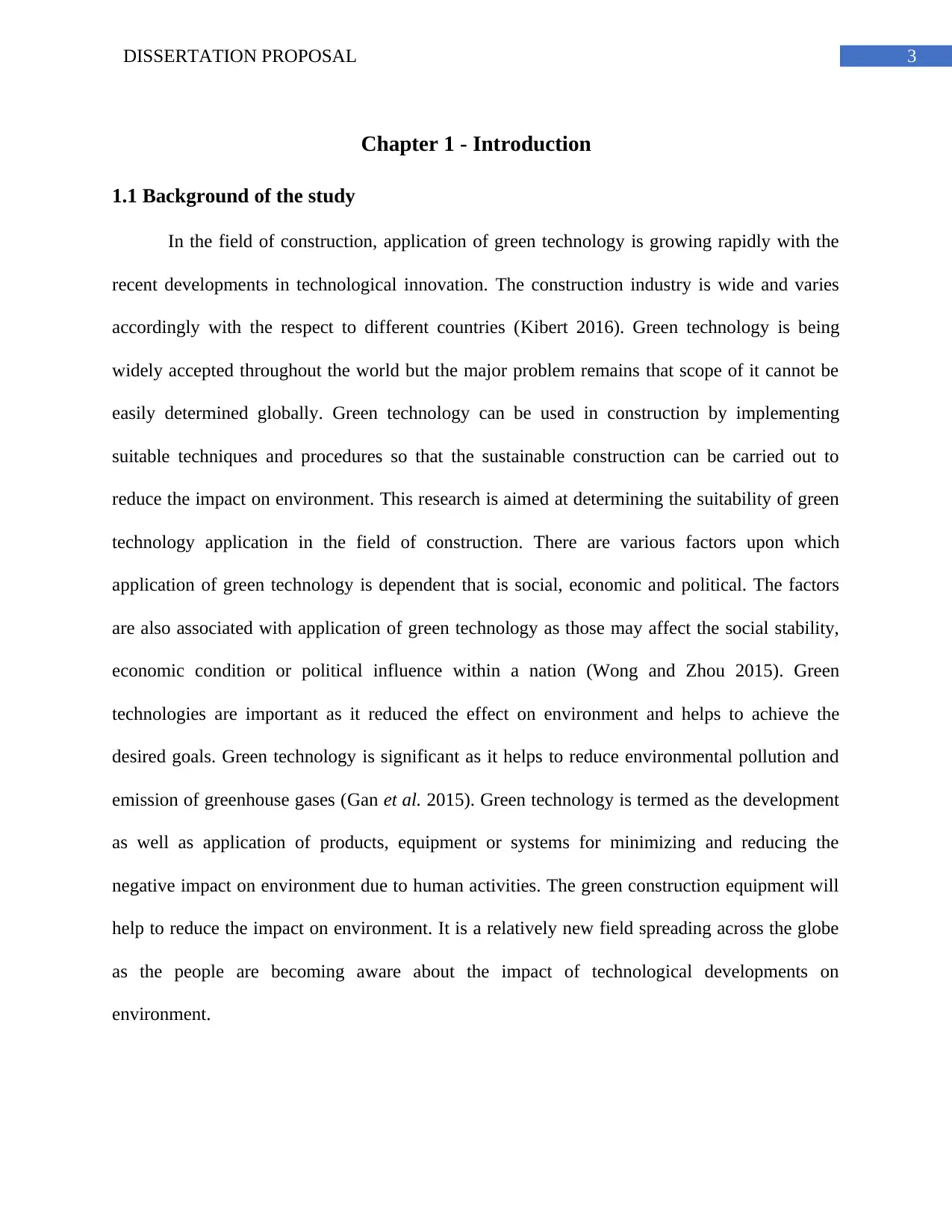
3DISSERTATION PROPOSAL
Chapter 1 - Introduction
1.1 Background of the study
In the field of construction, application of green technology is growing rapidly with the
recent developments in technological innovation. The construction industry is wide and varies
accordingly with the respect to different countries (Kibert 2016). Green technology is being
widely accepted throughout the world but the major problem remains that scope of it cannot be
easily determined globally. Green technology can be used in construction by implementing
suitable techniques and procedures so that the sustainable construction can be carried out to
reduce the impact on environment. This research is aimed at determining the suitability of green
technology application in the field of construction. There are various factors upon which
application of green technology is dependent that is social, economic and political. The factors
are also associated with application of green technology as those may affect the social stability,
economic condition or political influence within a nation (Wong and Zhou 2015). Green
technologies are important as it reduced the effect on environment and helps to achieve the
desired goals. Green technology is significant as it helps to reduce environmental pollution and
emission of greenhouse gases (Gan et al. 2015). Green technology is termed as the development
as well as application of products, equipment or systems for minimizing and reducing the
negative impact on environment due to human activities. The green construction equipment will
help to reduce the impact on environment. It is a relatively new field spreading across the globe
as the people are becoming aware about the impact of technological developments on
environment.
Chapter 1 - Introduction
1.1 Background of the study
In the field of construction, application of green technology is growing rapidly with the
recent developments in technological innovation. The construction industry is wide and varies
accordingly with the respect to different countries (Kibert 2016). Green technology is being
widely accepted throughout the world but the major problem remains that scope of it cannot be
easily determined globally. Green technology can be used in construction by implementing
suitable techniques and procedures so that the sustainable construction can be carried out to
reduce the impact on environment. This research is aimed at determining the suitability of green
technology application in the field of construction. There are various factors upon which
application of green technology is dependent that is social, economic and political. The factors
are also associated with application of green technology as those may affect the social stability,
economic condition or political influence within a nation (Wong and Zhou 2015). Green
technologies are important as it reduced the effect on environment and helps to achieve the
desired goals. Green technology is significant as it helps to reduce environmental pollution and
emission of greenhouse gases (Gan et al. 2015). Green technology is termed as the development
as well as application of products, equipment or systems for minimizing and reducing the
negative impact on environment due to human activities. The green construction equipment will
help to reduce the impact on environment. It is a relatively new field spreading across the globe
as the people are becoming aware about the impact of technological developments on
environment.
Paraphrase This Document
Need a fresh take? Get an instant paraphrase of this document with our AI Paraphraser
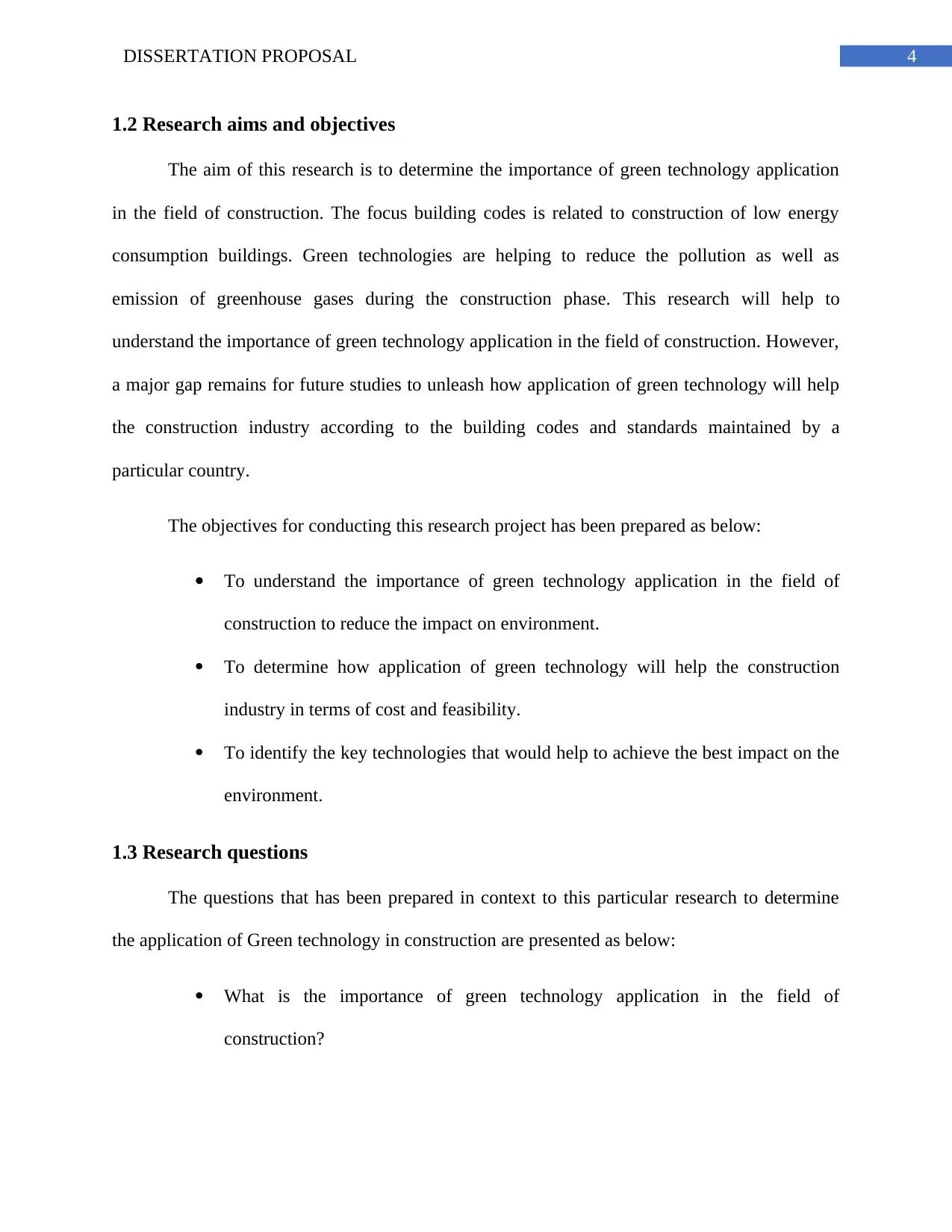
4DISSERTATION PROPOSAL
1.2 Research aims and objectives
The aim of this research is to determine the importance of green technology application
in the field of construction. The focus building codes is related to construction of low energy
consumption buildings. Green technologies are helping to reduce the pollution as well as
emission of greenhouse gases during the construction phase. This research will help to
understand the importance of green technology application in the field of construction. However,
a major gap remains for future studies to unleash how application of green technology will help
the construction industry according to the building codes and standards maintained by a
particular country.
The objectives for conducting this research project has been prepared as below:
To understand the importance of green technology application in the field of
construction to reduce the impact on environment.
To determine how application of green technology will help the construction
industry in terms of cost and feasibility.
To identify the key technologies that would help to achieve the best impact on the
environment.
1.3 Research questions
The questions that has been prepared in context to this particular research to determine
the application of Green technology in construction are presented as below:
What is the importance of green technology application in the field of
construction?
1.2 Research aims and objectives
The aim of this research is to determine the importance of green technology application
in the field of construction. The focus building codes is related to construction of low energy
consumption buildings. Green technologies are helping to reduce the pollution as well as
emission of greenhouse gases during the construction phase. This research will help to
understand the importance of green technology application in the field of construction. However,
a major gap remains for future studies to unleash how application of green technology will help
the construction industry according to the building codes and standards maintained by a
particular country.
The objectives for conducting this research project has been prepared as below:
To understand the importance of green technology application in the field of
construction to reduce the impact on environment.
To determine how application of green technology will help the construction
industry in terms of cost and feasibility.
To identify the key technologies that would help to achieve the best impact on the
environment.
1.3 Research questions
The questions that has been prepared in context to this particular research to determine
the application of Green technology in construction are presented as below:
What is the importance of green technology application in the field of
construction?
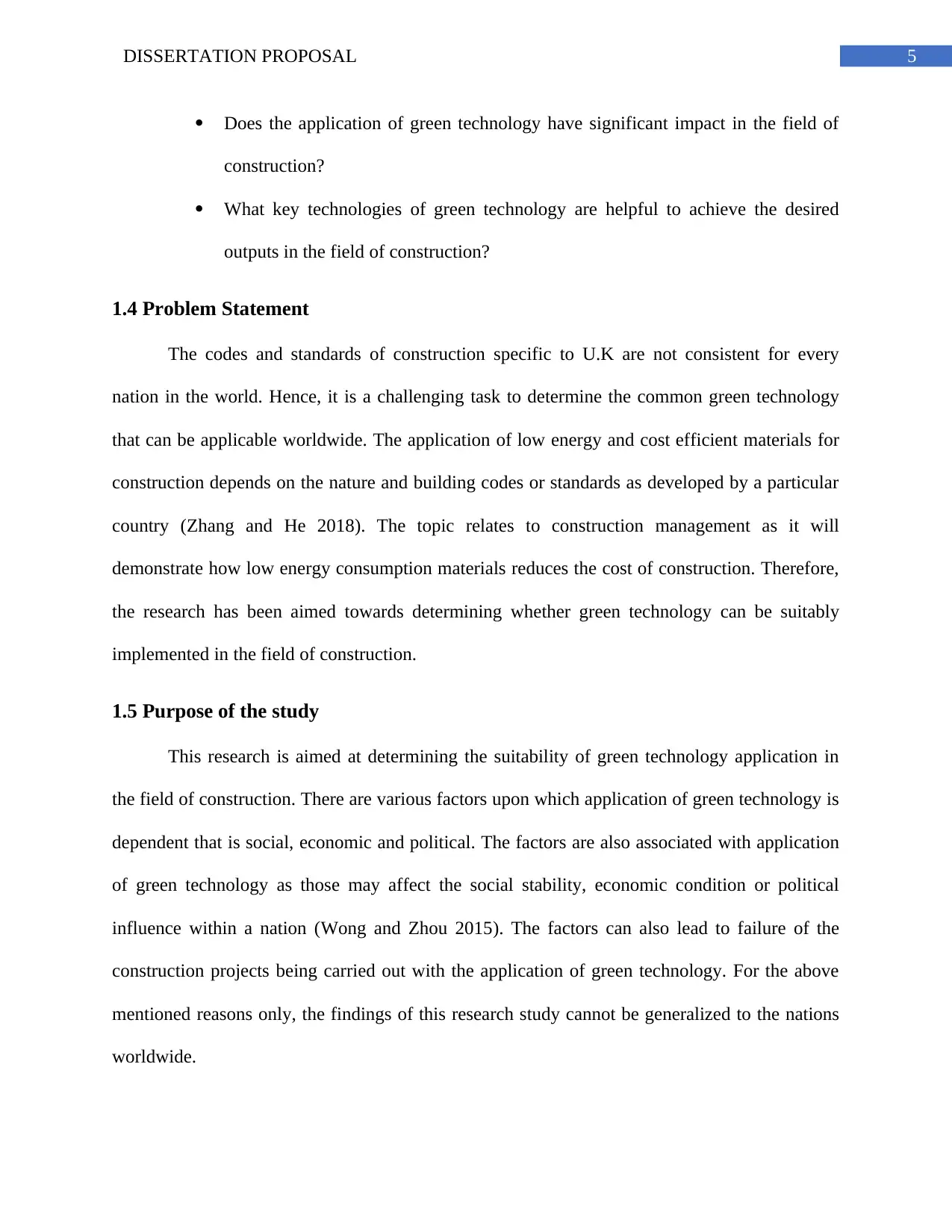
5DISSERTATION PROPOSAL
Does the application of green technology have significant impact in the field of
construction?
What key technologies of green technology are helpful to achieve the desired
outputs in the field of construction?
1.4 Problem Statement
The codes and standards of construction specific to U.K are not consistent for every
nation in the world. Hence, it is a challenging task to determine the common green technology
that can be applicable worldwide. The application of low energy and cost efficient materials for
construction depends on the nature and building codes or standards as developed by a particular
country (Zhang and He 2018). The topic relates to construction management as it will
demonstrate how low energy consumption materials reduces the cost of construction. Therefore,
the research has been aimed towards determining whether green technology can be suitably
implemented in the field of construction.
1.5 Purpose of the study
This research is aimed at determining the suitability of green technology application in
the field of construction. There are various factors upon which application of green technology is
dependent that is social, economic and political. The factors are also associated with application
of green technology as those may affect the social stability, economic condition or political
influence within a nation (Wong and Zhou 2015). The factors can also lead to failure of the
construction projects being carried out with the application of green technology. For the above
mentioned reasons only, the findings of this research study cannot be generalized to the nations
worldwide.
Does the application of green technology have significant impact in the field of
construction?
What key technologies of green technology are helpful to achieve the desired
outputs in the field of construction?
1.4 Problem Statement
The codes and standards of construction specific to U.K are not consistent for every
nation in the world. Hence, it is a challenging task to determine the common green technology
that can be applicable worldwide. The application of low energy and cost efficient materials for
construction depends on the nature and building codes or standards as developed by a particular
country (Zhang and He 2018). The topic relates to construction management as it will
demonstrate how low energy consumption materials reduces the cost of construction. Therefore,
the research has been aimed towards determining whether green technology can be suitably
implemented in the field of construction.
1.5 Purpose of the study
This research is aimed at determining the suitability of green technology application in
the field of construction. There are various factors upon which application of green technology is
dependent that is social, economic and political. The factors are also associated with application
of green technology as those may affect the social stability, economic condition or political
influence within a nation (Wong and Zhou 2015). The factors can also lead to failure of the
construction projects being carried out with the application of green technology. For the above
mentioned reasons only, the findings of this research study cannot be generalized to the nations
worldwide.
⊘ This is a preview!⊘
Do you want full access?
Subscribe today to unlock all pages.

Trusted by 1+ million students worldwide

6DISSERTATION PROPOSAL
Paraphrase This Document
Need a fresh take? Get an instant paraphrase of this document with our AI Paraphraser
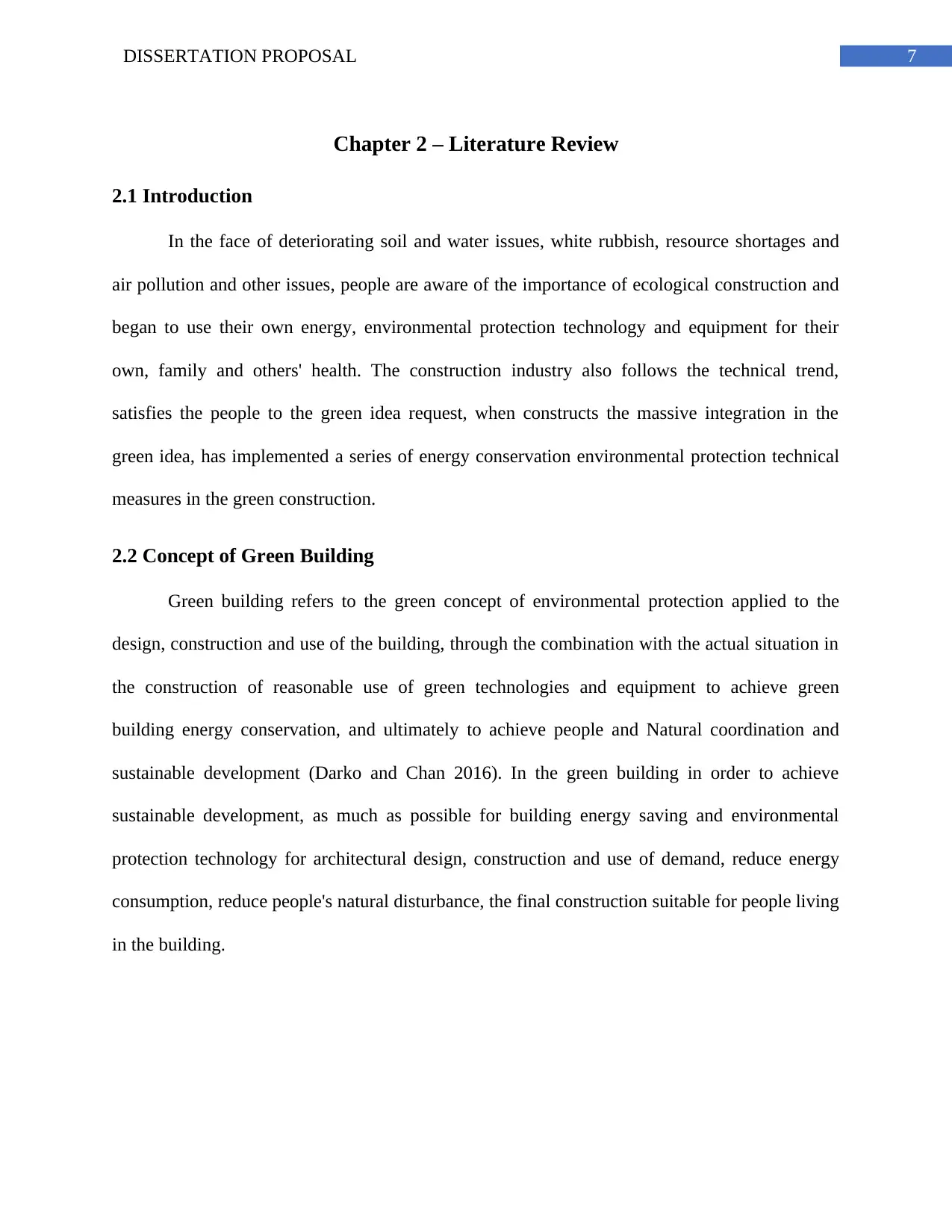
7DISSERTATION PROPOSAL
Chapter 2 – Literature Review
2.1 Introduction
In the face of deteriorating soil and water issues, white rubbish, resource shortages and
air pollution and other issues, people are aware of the importance of ecological construction and
began to use their own energy, environmental protection technology and equipment for their
own, family and others' health. The construction industry also follows the technical trend,
satisfies the people to the green idea request, when constructs the massive integration in the
green idea, has implemented a series of energy conservation environmental protection technical
measures in the green construction.
2.2 Concept of Green Building
Green building refers to the green concept of environmental protection applied to the
design, construction and use of the building, through the combination with the actual situation in
the construction of reasonable use of green technologies and equipment to achieve green
building energy conservation, and ultimately to achieve people and Natural coordination and
sustainable development (Darko and Chan 2016). In the green building in order to achieve
sustainable development, as much as possible for building energy saving and environmental
protection technology for architectural design, construction and use of demand, reduce energy
consumption, reduce people's natural disturbance, the final construction suitable for people living
in the building.
Chapter 2 – Literature Review
2.1 Introduction
In the face of deteriorating soil and water issues, white rubbish, resource shortages and
air pollution and other issues, people are aware of the importance of ecological construction and
began to use their own energy, environmental protection technology and equipment for their
own, family and others' health. The construction industry also follows the technical trend,
satisfies the people to the green idea request, when constructs the massive integration in the
green idea, has implemented a series of energy conservation environmental protection technical
measures in the green construction.
2.2 Concept of Green Building
Green building refers to the green concept of environmental protection applied to the
design, construction and use of the building, through the combination with the actual situation in
the construction of reasonable use of green technologies and equipment to achieve green
building energy conservation, and ultimately to achieve people and Natural coordination and
sustainable development (Darko and Chan 2016). In the green building in order to achieve
sustainable development, as much as possible for building energy saving and environmental
protection technology for architectural design, construction and use of demand, reduce energy
consumption, reduce people's natural disturbance, the final construction suitable for people living
in the building.
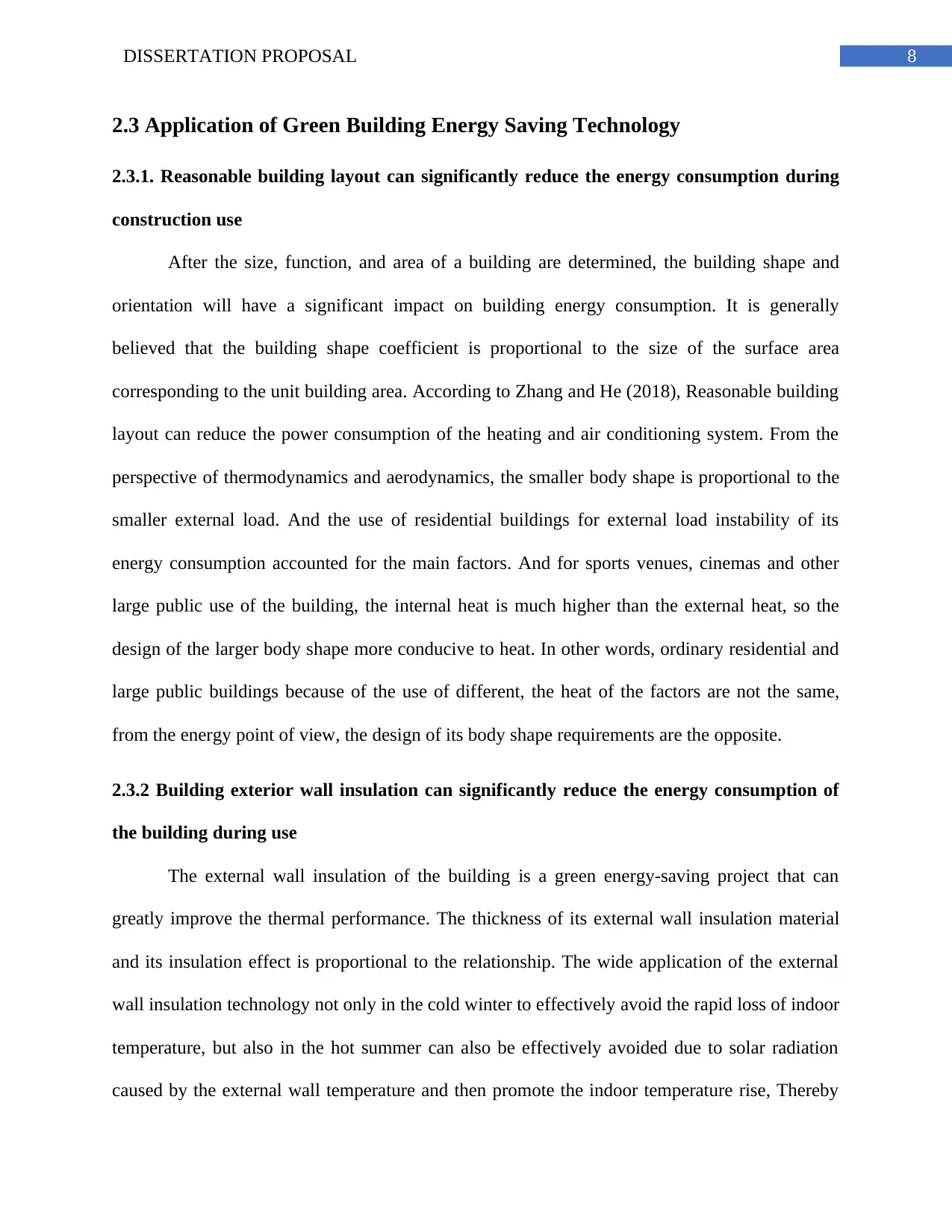
8DISSERTATION PROPOSAL
2.3 Application of Green Building Energy Saving Technology
2.3.1. Reasonable building layout can significantly reduce the energy consumption during
construction use
After the size, function, and area of a building are determined, the building shape and
orientation will have a significant impact on building energy consumption. It is generally
believed that the building shape coefficient is proportional to the size of the surface area
corresponding to the unit building area. According to Zhang and He (2018), Reasonable building
layout can reduce the power consumption of the heating and air conditioning system. From the
perspective of thermodynamics and aerodynamics, the smaller body shape is proportional to the
smaller external load. And the use of residential buildings for external load instability of its
energy consumption accounted for the main factors. And for sports venues, cinemas and other
large public use of the building, the internal heat is much higher than the external heat, so the
design of the larger body shape more conducive to heat. In other words, ordinary residential and
large public buildings because of the use of different, the heat of the factors are not the same,
from the energy point of view, the design of its body shape requirements are the opposite.
2.3.2 Building exterior wall insulation can significantly reduce the energy consumption of
the building during use
The external wall insulation of the building is a green energy-saving project that can
greatly improve the thermal performance. The thickness of its external wall insulation material
and its insulation effect is proportional to the relationship. The wide application of the external
wall insulation technology not only in the cold winter to effectively avoid the rapid loss of indoor
temperature, but also in the hot summer can also be effectively avoided due to solar radiation
caused by the external wall temperature and then promote the indoor temperature rise, Thereby
2.3 Application of Green Building Energy Saving Technology
2.3.1. Reasonable building layout can significantly reduce the energy consumption during
construction use
After the size, function, and area of a building are determined, the building shape and
orientation will have a significant impact on building energy consumption. It is generally
believed that the building shape coefficient is proportional to the size of the surface area
corresponding to the unit building area. According to Zhang and He (2018), Reasonable building
layout can reduce the power consumption of the heating and air conditioning system. From the
perspective of thermodynamics and aerodynamics, the smaller body shape is proportional to the
smaller external load. And the use of residential buildings for external load instability of its
energy consumption accounted for the main factors. And for sports venues, cinemas and other
large public use of the building, the internal heat is much higher than the external heat, so the
design of the larger body shape more conducive to heat. In other words, ordinary residential and
large public buildings because of the use of different, the heat of the factors are not the same,
from the energy point of view, the design of its body shape requirements are the opposite.
2.3.2 Building exterior wall insulation can significantly reduce the energy consumption of
the building during use
The external wall insulation of the building is a green energy-saving project that can
greatly improve the thermal performance. The thickness of its external wall insulation material
and its insulation effect is proportional to the relationship. The wide application of the external
wall insulation technology not only in the cold winter to effectively avoid the rapid loss of indoor
temperature, but also in the hot summer can also be effectively avoided due to solar radiation
caused by the external wall temperature and then promote the indoor temperature rise, Thereby
⊘ This is a preview!⊘
Do you want full access?
Subscribe today to unlock all pages.

Trusted by 1+ million students worldwide
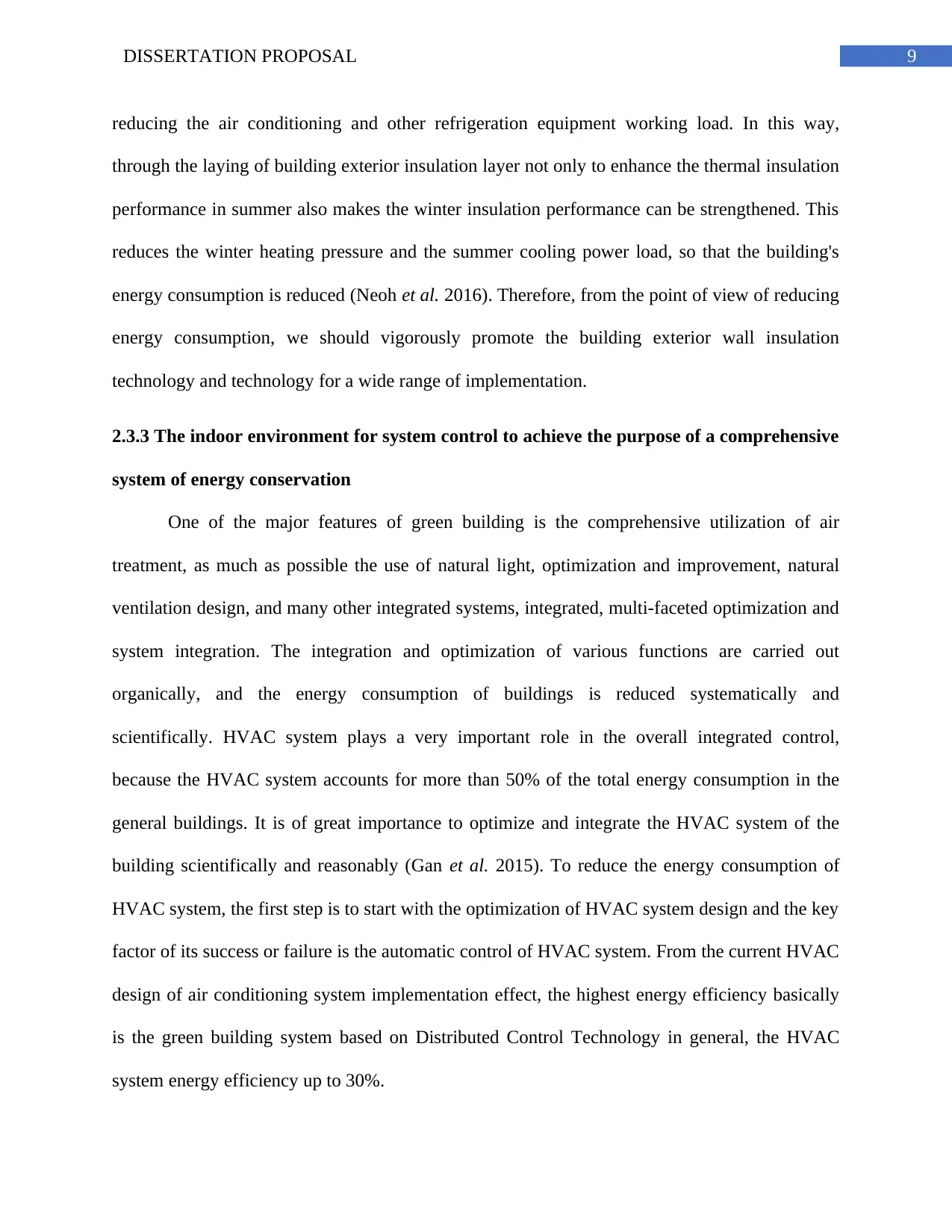
9DISSERTATION PROPOSAL
reducing the air conditioning and other refrigeration equipment working load. In this way,
through the laying of building exterior insulation layer not only to enhance the thermal insulation
performance in summer also makes the winter insulation performance can be strengthened. This
reduces the winter heating pressure and the summer cooling power load, so that the building's
energy consumption is reduced (Neoh et al. 2016). Therefore, from the point of view of reducing
energy consumption, we should vigorously promote the building exterior wall insulation
technology and technology for a wide range of implementation.
2.3.3 The indoor environment for system control to achieve the purpose of a comprehensive
system of energy conservation
One of the major features of green building is the comprehensive utilization of air
treatment, as much as possible the use of natural light, optimization and improvement, natural
ventilation design, and many other integrated systems, integrated, multi-faceted optimization and
system integration. The integration and optimization of various functions are carried out
organically, and the energy consumption of buildings is reduced systematically and
scientifically. HVAC system plays a very important role in the overall integrated control,
because the HVAC system accounts for more than 50% of the total energy consumption in the
general buildings. It is of great importance to optimize and integrate the HVAC system of the
building scientifically and reasonably (Gan et al. 2015). To reduce the energy consumption of
HVAC system, the first step is to start with the optimization of HVAC system design and the key
factor of its success or failure is the automatic control of HVAC system. From the current HVAC
design of air conditioning system implementation effect, the highest energy efficiency basically
is the green building system based on Distributed Control Technology in general, the HVAC
system energy efficiency up to 30%.
reducing the air conditioning and other refrigeration equipment working load. In this way,
through the laying of building exterior insulation layer not only to enhance the thermal insulation
performance in summer also makes the winter insulation performance can be strengthened. This
reduces the winter heating pressure and the summer cooling power load, so that the building's
energy consumption is reduced (Neoh et al. 2016). Therefore, from the point of view of reducing
energy consumption, we should vigorously promote the building exterior wall insulation
technology and technology for a wide range of implementation.
2.3.3 The indoor environment for system control to achieve the purpose of a comprehensive
system of energy conservation
One of the major features of green building is the comprehensive utilization of air
treatment, as much as possible the use of natural light, optimization and improvement, natural
ventilation design, and many other integrated systems, integrated, multi-faceted optimization and
system integration. The integration and optimization of various functions are carried out
organically, and the energy consumption of buildings is reduced systematically and
scientifically. HVAC system plays a very important role in the overall integrated control,
because the HVAC system accounts for more than 50% of the total energy consumption in the
general buildings. It is of great importance to optimize and integrate the HVAC system of the
building scientifically and reasonably (Gan et al. 2015). To reduce the energy consumption of
HVAC system, the first step is to start with the optimization of HVAC system design and the key
factor of its success or failure is the automatic control of HVAC system. From the current HVAC
design of air conditioning system implementation effect, the highest energy efficiency basically
is the green building system based on Distributed Control Technology in general, the HVAC
system energy efficiency up to 30%.
Paraphrase This Document
Need a fresh take? Get an instant paraphrase of this document with our AI Paraphraser
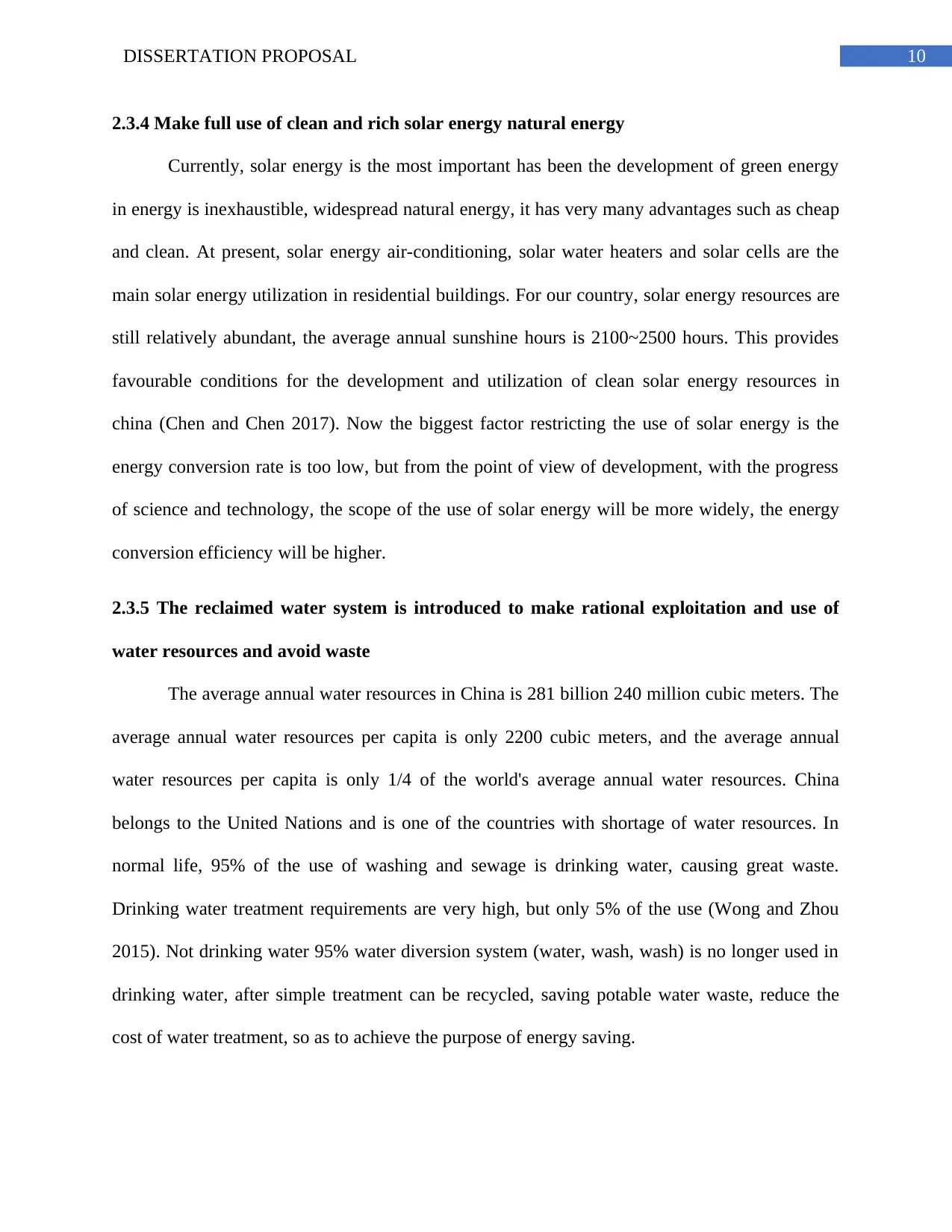
10DISSERTATION PROPOSAL
2.3.4 Make full use of clean and rich solar energy natural energy
Currently, solar energy is the most important has been the development of green energy
in energy is inexhaustible, widespread natural energy, it has very many advantages such as cheap
and clean. At present, solar energy air-conditioning, solar water heaters and solar cells are the
main solar energy utilization in residential buildings. For our country, solar energy resources are
still relatively abundant, the average annual sunshine hours is 2100~2500 hours. This provides
favourable conditions for the development and utilization of clean solar energy resources in
china (Chen and Chen 2017). Now the biggest factor restricting the use of solar energy is the
energy conversion rate is too low, but from the point of view of development, with the progress
of science and technology, the scope of the use of solar energy will be more widely, the energy
conversion efficiency will be higher.
2.3.5 The reclaimed water system is introduced to make rational exploitation and use of
water resources and avoid waste
The average annual water resources in China is 281 billion 240 million cubic meters. The
average annual water resources per capita is only 2200 cubic meters, and the average annual
water resources per capita is only 1/4 of the world's average annual water resources. China
belongs to the United Nations and is one of the countries with shortage of water resources. In
normal life, 95% of the use of washing and sewage is drinking water, causing great waste.
Drinking water treatment requirements are very high, but only 5% of the use (Wong and Zhou
2015). Not drinking water 95% water diversion system (water, wash, wash) is no longer used in
drinking water, after simple treatment can be recycled, saving potable water waste, reduce the
cost of water treatment, so as to achieve the purpose of energy saving.
2.3.4 Make full use of clean and rich solar energy natural energy
Currently, solar energy is the most important has been the development of green energy
in energy is inexhaustible, widespread natural energy, it has very many advantages such as cheap
and clean. At present, solar energy air-conditioning, solar water heaters and solar cells are the
main solar energy utilization in residential buildings. For our country, solar energy resources are
still relatively abundant, the average annual sunshine hours is 2100~2500 hours. This provides
favourable conditions for the development and utilization of clean solar energy resources in
china (Chen and Chen 2017). Now the biggest factor restricting the use of solar energy is the
energy conversion rate is too low, but from the point of view of development, with the progress
of science and technology, the scope of the use of solar energy will be more widely, the energy
conversion efficiency will be higher.
2.3.5 The reclaimed water system is introduced to make rational exploitation and use of
water resources and avoid waste
The average annual water resources in China is 281 billion 240 million cubic meters. The
average annual water resources per capita is only 2200 cubic meters, and the average annual
water resources per capita is only 1/4 of the world's average annual water resources. China
belongs to the United Nations and is one of the countries with shortage of water resources. In
normal life, 95% of the use of washing and sewage is drinking water, causing great waste.
Drinking water treatment requirements are very high, but only 5% of the use (Wong and Zhou
2015). Not drinking water 95% water diversion system (water, wash, wash) is no longer used in
drinking water, after simple treatment can be recycled, saving potable water waste, reduce the
cost of water treatment, so as to achieve the purpose of energy saving.
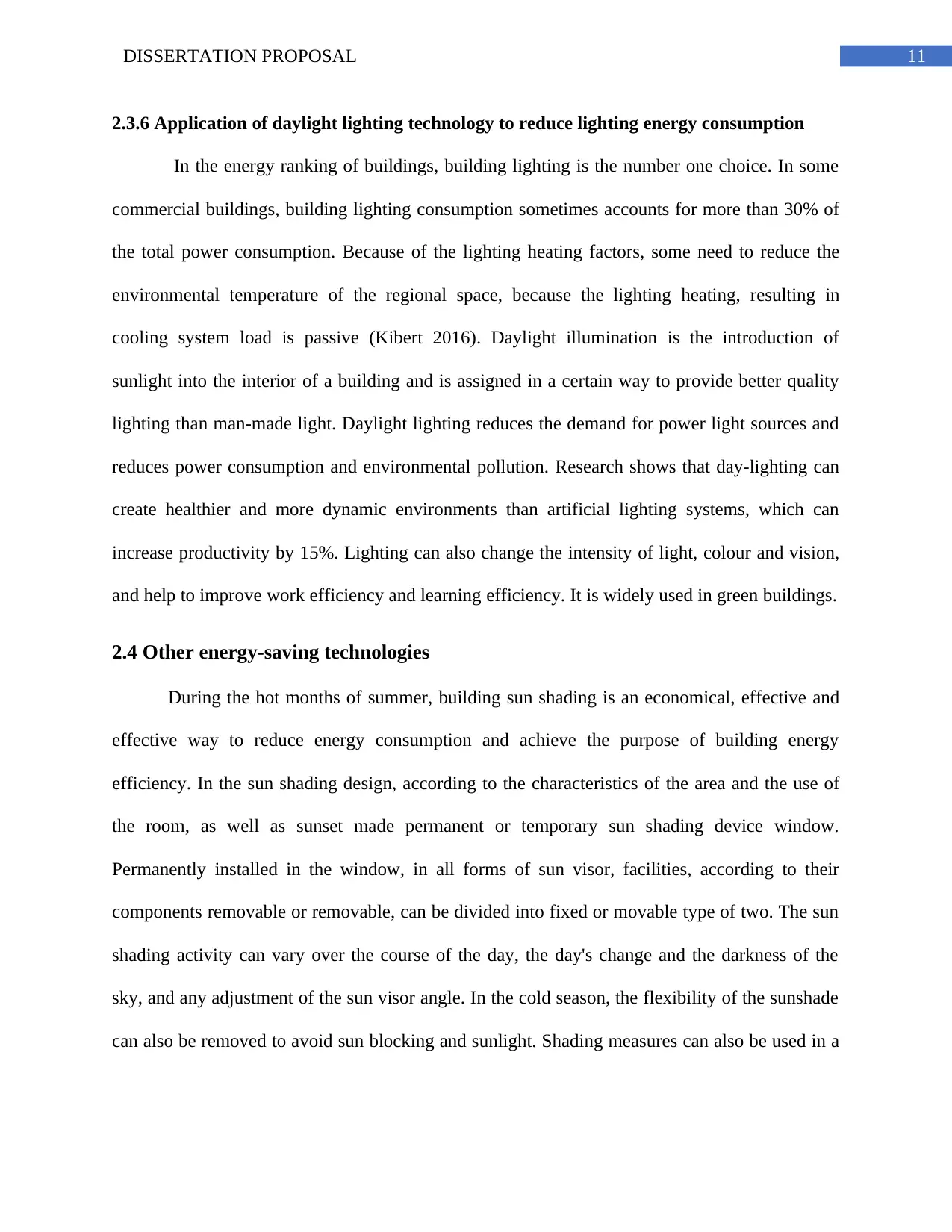
11DISSERTATION PROPOSAL
2.3.6 Application of daylight lighting technology to reduce lighting energy consumption
In the energy ranking of buildings, building lighting is the number one choice. In some
commercial buildings, building lighting consumption sometimes accounts for more than 30% of
the total power consumption. Because of the lighting heating factors, some need to reduce the
environmental temperature of the regional space, because the lighting heating, resulting in
cooling system load is passive (Kibert 2016). Daylight illumination is the introduction of
sunlight into the interior of a building and is assigned in a certain way to provide better quality
lighting than man-made light. Daylight lighting reduces the demand for power light sources and
reduces power consumption and environmental pollution. Research shows that day-lighting can
create healthier and more dynamic environments than artificial lighting systems, which can
increase productivity by 15%. Lighting can also change the intensity of light, colour and vision,
and help to improve work efficiency and learning efficiency. It is widely used in green buildings.
2.4 Other energy-saving technologies
During the hot months of summer, building sun shading is an economical, effective and
effective way to reduce energy consumption and achieve the purpose of building energy
efficiency. In the sun shading design, according to the characteristics of the area and the use of
the room, as well as sunset made permanent or temporary sun shading device window.
Permanently installed in the window, in all forms of sun visor, facilities, according to their
components removable or removable, can be divided into fixed or movable type of two. The sun
shading activity can vary over the course of the day, the day's change and the darkness of the
sky, and any adjustment of the sun visor angle. In the cold season, the flexibility of the sunshade
can also be removed to avoid sun blocking and sunlight. Shading measures can also be used in a
2.3.6 Application of daylight lighting technology to reduce lighting energy consumption
In the energy ranking of buildings, building lighting is the number one choice. In some
commercial buildings, building lighting consumption sometimes accounts for more than 30% of
the total power consumption. Because of the lighting heating factors, some need to reduce the
environmental temperature of the regional space, because the lighting heating, resulting in
cooling system load is passive (Kibert 2016). Daylight illumination is the introduction of
sunlight into the interior of a building and is assigned in a certain way to provide better quality
lighting than man-made light. Daylight lighting reduces the demand for power light sources and
reduces power consumption and environmental pollution. Research shows that day-lighting can
create healthier and more dynamic environments than artificial lighting systems, which can
increase productivity by 15%. Lighting can also change the intensity of light, colour and vision,
and help to improve work efficiency and learning efficiency. It is widely used in green buildings.
2.4 Other energy-saving technologies
During the hot months of summer, building sun shading is an economical, effective and
effective way to reduce energy consumption and achieve the purpose of building energy
efficiency. In the sun shading design, according to the characteristics of the area and the use of
the room, as well as sunset made permanent or temporary sun shading device window.
Permanently installed in the window, in all forms of sun visor, facilities, according to their
components removable or removable, can be divided into fixed or movable type of two. The sun
shading activity can vary over the course of the day, the day's change and the darkness of the
sky, and any adjustment of the sun visor angle. In the cold season, the flexibility of the sunshade
can also be removed to avoid sun blocking and sunlight. Shading measures can also be used in a
⊘ This is a preview!⊘
Do you want full access?
Subscribe today to unlock all pages.

Trusted by 1+ million students worldwide
1 out of 37
Related Documents
Your All-in-One AI-Powered Toolkit for Academic Success.
+13062052269
info@desklib.com
Available 24*7 on WhatsApp / Email
![[object Object]](/_next/static/media/star-bottom.7253800d.svg)
Unlock your academic potential
Copyright © 2020–2025 A2Z Services. All Rights Reserved. Developed and managed by ZUCOL.





